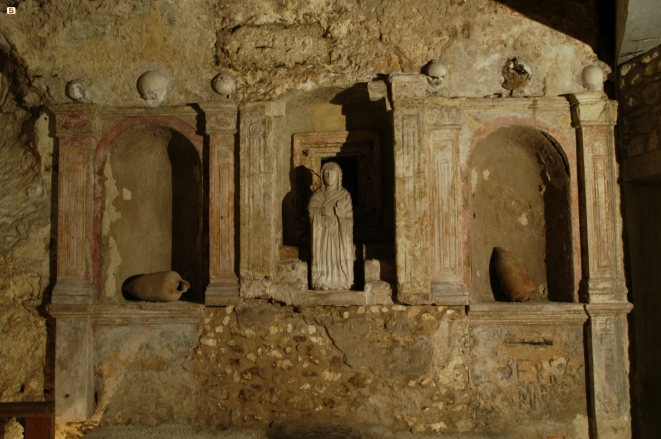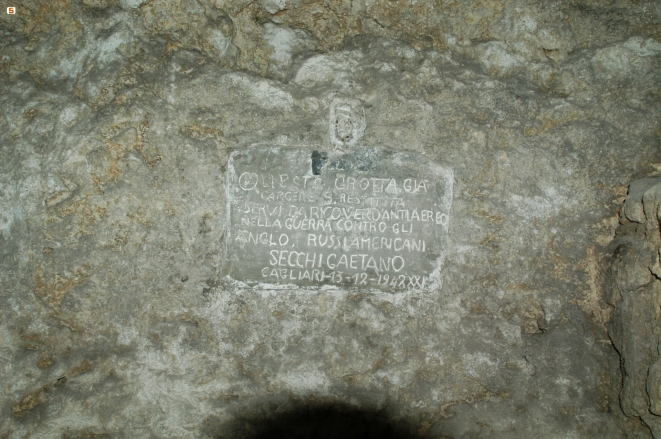The crypt of Saint Restituta
A curative cave in the subsoil of the city
In the old town center of Cagliari, in the Stampace District, almost in the end of the acclaimed Carlo Felice Boulevard, and leaving behind the port area, but, not the typical perfume of the sea of the sun city, there is an epic curative cave, according to the centuries-old and chimerical Sardinian people’s tradition, the Santa Restituta crypt.
Under the namesake Church, the cave presents a precipituous staircase that leads towards the location where her cult, her imprisonment, her martyrdom, but, the legend, too, began. Indeed, in a column isolated in loco, she would be tied, tortured, but, since she was still devoted to her credo, she was burnt living.
From that moment onwards, until 1800, according to people’s tradition, the crypt began a spring of healing for who was affected by the life in own physical integrity and that went to the sacred place and enveloped in the mystic atmosphere, sprinkling with the land of the subsoil. People looked for the characteristic healing through the execution of miraculous ceremonies, able to restore the psycho-physical equilibrium removing miraculously the cause of the malaise.

Dated back to the Christian Middle Ages, the miraculous ceremonies were made by the kings of France and England, because they had the supernatural curative power derived from the royal divinity, though God gives them this power through the Pope, by the sacrament of the unction through the sacred chrism. About the people’s religiousness and the Christian Church, the saint has the authority of being miracle worker. Through this implication, there is the healing nature of the crypt, because it comes from the Saint martyr.
It was exclusive the way of nursing the children that were affected by smallpox, according to the mythical tradition. Led in the loco sanitatum, they went to the room of the column of martyrdom and they were made lied on the floor, where they had to roll many times for picking up the dust of the miracle that was liberating of the evil. But, the legend is linked to the legend: the column itself is the subject of a people’s belief marginalized for its scandalous nature.
The place of the torture of the Saint becomes the pillar of fertility ceremonies for sterile women, who moved with a no feminine and no discrete way, in order to facilitate a miraculous conception. The stir was such that the Church had to intervene for controlling the events that were no appropriate to the Catholic cult and "for avoiding some abuses that are done” according to Giovanni Spano, the presbyter. It was a gift of Christian release that was given by the martyr, according to the Sardinian people’s tradition, that is deduced by the name of the God-fearing.

The etymological peculiarity is almost a symbol of the union of the historical situation of the Martyr, defender of the Christian cult despite her role of instigator of the anger of Diocleziano, and the mythical healing power of her sacred location, a praise of the speech of the Messiah and of the Trinity. The name originates from Latin restituta-restitutus, whose meaning is the return to the true faith through the sacramental baptism that gives release according to the will of the Creator. The similarity of the origin with reparata, is immediate because the return can be interpreted as having again, recover a lost affection like that linked to the death of a son. In this terminological perspective, the Christian release is reached by virtue of the offsetting birth of a next heir.
So, there is an only theme: the return. We can find it in the mythical vision of the cave as a place that gave the health. Restituta, as a saint, gives healing thanks to her ancient and hidden location of prayer that persists in divulging despite the Christian persecutions wanted by Diocleziano and that led her towards the death with the martyrs of Abitina. A location become her prison and that is composed by an hypogeum, that is for one part a natural cave, used as an anti-aircraft refuge during the bombardments of the Second World War. It was the period when her relics, discovered through the excavatings in 1614, were led to the Sant'Anna Church for avoiding the dispersion.
The cavity is spread in a central space whose walls were full of paintings and frescos, of which there is only that of Saint Giovanni Battista of the Eighteenth Century, with his right hand as a sign of benediction; on the contrary, in the high altar there is the marble statue of the Saint. It is obvious how Sardinia in general and Cagliari in particular has the specific and original peculiarity of define itself for its ancient tales transmitted by a generational voice, as it was done during the best years in the past. From a short story, spread from the night of the times, culture, history and a past of a Sardinian proud population erect indisputable and we can discover them exactly there, in a small corner of the city.